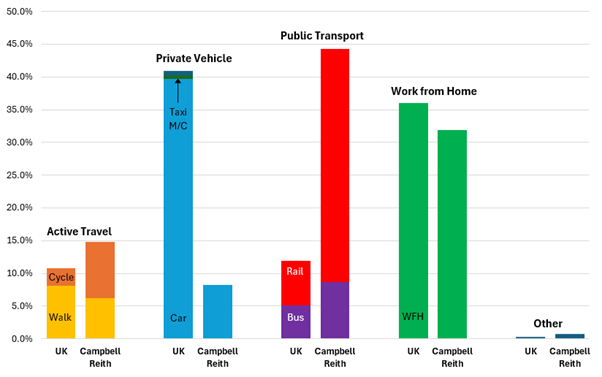As part of the services offered, CampbellReith prepare and supply Travel Plans alongside other supporting documents and drawings to assist our clients’ planning applications.
These bespoke documents can be set up for either a speculative development or a known occupier and are intended to help employees make sustainable transport choices, with an overarching aim to reduce the number of single occupancy car journeys to and from work.
By focussing on reducing single car occupancy and encouraging use of more sustainable modes of transport where possible, this can reduce local traffic congestion, resulting in improvements in road safety, and importantly, improvements in air quality because of reduced vehicle emissions.

For Travel Plans that are for a known occupier, we can prepare and analyse staff travel surveys to understand what incentives or initiatives could encourage mode change when commuting.
At CampbellReith, we have several measures in place to encourage sustainable commuting habits, including:
- Offices centrally located for good access by public transport
- Modern facilities with internal secure cycle storage, lockers and staff shower facilities
- Low levels of on-site parking to discourage driving to work, unless necessary
- Access to cycle to work schemes and season ticket loans
We undertake our own surveys of staff travel and while the 2024-25 results are being recorded, for the 2023-24 year, we have compared our staff mode split against that recorded in the National Travel Survey during 2024.
The graph below shows a comparison of the UK average mode split for commuters, compared to that of CampbellReith staff. The bars have been grouped to cover Active Travel (i.e., walking and cycling), Private Vehicle use (Cars, Motorcycles and Taxis), Public Transport (including all types of rail travel) and finally Work from Home. This final statistic has been weighted to consider the number of days which staff at CampbellReith work from home, and is compared against a Stanford University Study which took a more detailed view of UK hybrid working than the UK’s own surveys.

As shown, there is a notable difference between the UK and CampbellReith mode split, particularly when comparing Private Vehicle use against Public Transport use. The key takeaway from this graph is that even while CampbellReith staff choose to work in the office more often than the UK average, the number of people travelling by private vehicle is far fewer. By considering the UK average modal split, versus a member of CampbellReith staff, then over the course of a year, each member of CampbellReith staff saves around 300kg of CO2 equivalent per year on average. This is referred to as 300kgCO2e and equates all greenhouse gas emissions to a common unit of Carbon Dioxide Equivalent for ease of comparison.
To try and quantify what 300kgCO2e equates to, it is generally accepted that in the 20 years it takes for an average tree to reach maturity, it will absorb around 220kg of CO2. Therefore, by applying this to our staff travel to work habits, for every ten staff, each year we are saving the carbon emissions that thirteen trees would absorb over twenty years.

What this shows is that in the first instance, the notion of planting trees to offset CO2 emissions requires a lot of trees and takes a lot of time to achieve a meaningful change. Given that ten staff using less polluting methods of commuting can achieve the same CO2 reductions in a year, as it would take thirteen trees twenty years to achieve, it is clear that as responsible consultants, scientists and engineers, we should actively try to travel by less polluting means when we can, given the considerable reductions we can make as the individual, or as a collective.